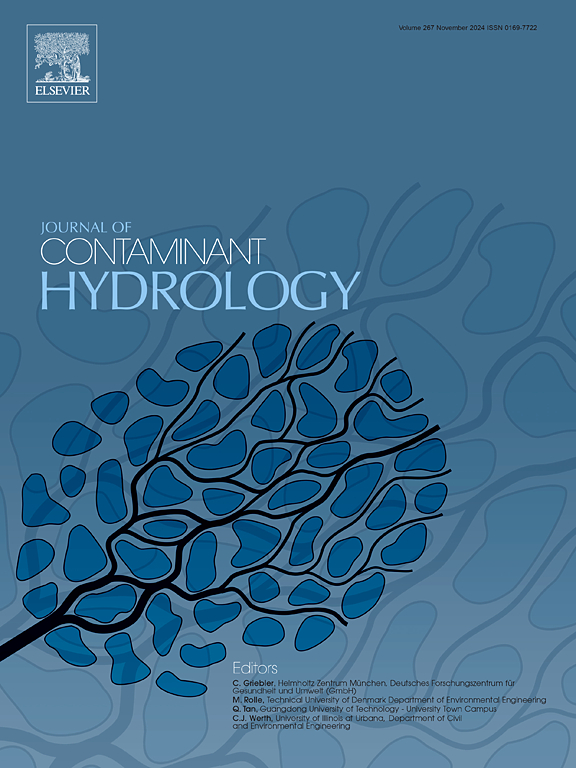Innovative use of recycled aluminum adsorbent for methylene blue adsorption and post-application for soil stabilization
IF 3.5
3区 环境科学与生态学
Q2 ENVIRONMENTAL SCIENCES
引用次数: 0
Abstract
Methylene blue (MTB) dye from the textile manufacturing industry is harmful to the ecological environment and human health in aquatic ecosystems due to its toxicity, environmental resistance, and bioaccumulation. This study investigates the potential of aluminum oxide nanoparticles (AONPs) sourced from industrial swarf waste as a sorbent for removing MTB dye in wastewater. Under optimized conditions of 6 (pH), 200 (rpm), and 30 (minutes), 97.34 % removal was observed, and 48.65 mg. g−1 uptake capacity of the adsorbent was achieved. The adsorption process obeyed the Langmuir model with monolayer adsorption on a surface. It conformed with a pseudo-second-order kinetic model (R2 = 0.9878), indicating that the chemisorption is the rate-controlling step. Thermodynamic analyses showed that the adsorption process is exothermic and spontaneous, thus confirming the feasibility and eco-friendliness of the potential low-cost adsorbent for MTB dye removal from wastewater. The AONPs after methylene blue dye removal, were integrated into clayey soil at an appropriate concentration of 1 % to assess their influence on geotechnical parameters. Experimental findings indicated substantial enhancements, with maximum dry density rising from 1660 kg/m3 to 1700 kg/m3 and unconfined compressive strength increasing from 143.9 kPa to 198.6 kPa, with a decrease in plasticity index and liquid limit. These improvements are attributed to the nanoparticles' capacity to occupy soil voids, reduce porosity, and increase interparticle bonding. Applying AONPs offers a cost-effective and eco-friendly method for treating dyes in wastewater, while concurrently enhancing soil characteristics and promoting sustainable wastewater treatment and soil stability.
创新使用再生铝吸附剂对亚甲基蓝的吸附和后应用土壤稳定
纺织工业生产的亚甲基蓝染料由于其毒性、环境抗性和生物蓄积性,对生态环境和水生生态系统的人体健康造成危害。本研究探讨了来自工业废料的氧化铝纳米颗粒(AONPs)作为吸附剂去除废水中MTB染料的潜力。在6 (pH)、200 (rpm)和30 (min)的优化条件下,脱除率为97.34%,脱除率为48.65 mg。获得了吸附剂对G−1的吸附能力。吸附过程符合Langmuir模型,表面为单层吸附。符合拟二级动力学模型(R2 = 0.9878),表明化学吸附是控制反应速率的步骤。热力学分析表明,吸附过程为放热自发过程,从而证实了该低成本吸附剂去除废水中MTB染料的可行性和生态友好性。去除亚甲基蓝染料后,将AONPs以1%的适当浓度掺入粘土中,评估其对岩土参数的影响。实验结果表明,最大干密度从1660 kg/m3增加到1700 kg/m3,无侧限抗压强度从143.9 kPa增加到198.6 kPa,塑性指数和液限均有所降低。这些改进归功于纳米颗粒占据土壤空隙、减少孔隙度和增加颗粒间结合的能力。应用AONPs为处理废水中的染料提供了一种经济、环保的方法,同时改善了土壤特性,促进了废水的可持续处理和土壤的稳定性。
本文章由计算机程序翻译,如有差异,请以英文原文为准。
求助全文
约1分钟内获得全文
求助全文
来源期刊

Journal of contaminant hydrology
环境科学-地球科学综合
CiteScore
6.80
自引率
2.80%
发文量
129
审稿时长
68 days
期刊介绍:
The Journal of Contaminant Hydrology is an international journal publishing scientific articles pertaining to the contamination of subsurface water resources. Emphasis is placed on investigations of the physical, chemical, and biological processes influencing the behavior and fate of organic and inorganic contaminants in the unsaturated (vadose) and saturated (groundwater) zones, as well as at groundwater-surface water interfaces. The ecological impacts of contaminants transported both from and to aquifers are of interest. Articles on contamination of surface water only, without a link to groundwater, are out of the scope. Broad latitude is allowed in identifying contaminants of interest, and include legacy and emerging pollutants, nutrients, nanoparticles, pathogenic microorganisms (e.g., bacteria, viruses, protozoa), microplastics, and various constituents associated with energy production (e.g., methane, carbon dioxide, hydrogen sulfide).
The journal''s scope embraces a wide range of topics including: experimental investigations of contaminant sorption, diffusion, transformation, volatilization and transport in the surface and subsurface; characterization of soil and aquifer properties only as they influence contaminant behavior; development and testing of mathematical models of contaminant behaviour; innovative techniques for restoration of contaminated sites; development of new tools or techniques for monitoring the extent of soil and groundwater contamination; transformation of contaminants in the hyporheic zone; effects of contaminants traversing the hyporheic zone on surface water and groundwater ecosystems; subsurface carbon sequestration and/or turnover; and migration of fluids associated with energy production into groundwater.
 求助内容:
求助内容: 应助结果提醒方式:
应助结果提醒方式:


